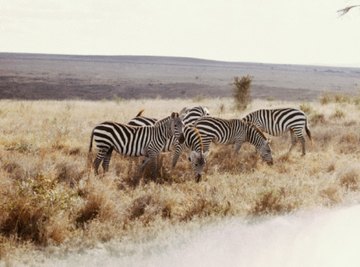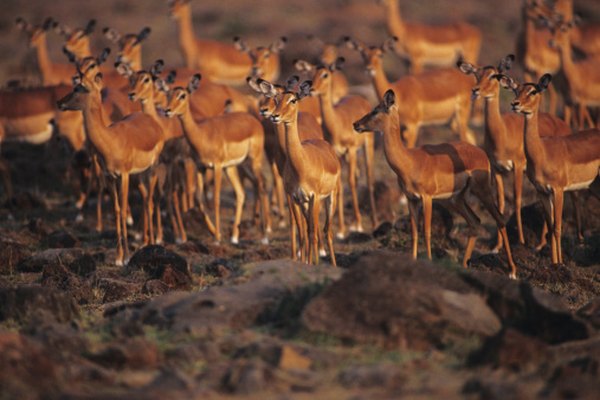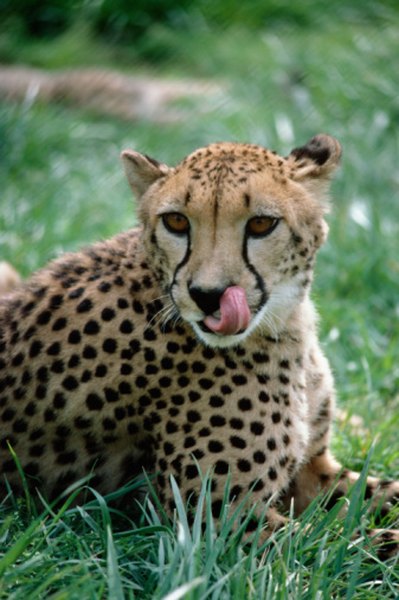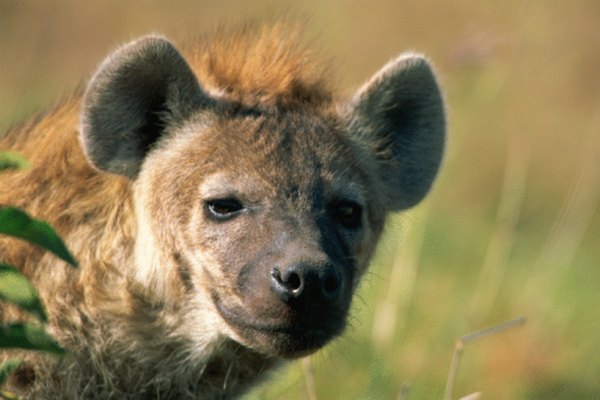
Savannas are dominated by grasslands, with trees scattered only sporadically across the land. A savanna has two main seasons, wet and dry. Since the dry season is long, animals have learned to adapt to stay alive, keeping the ecosystem in balance. Savannas exist in areas such as Australia, South America and Africa. However, Africa contains the richest diversity of animals, notes the Blue Planet Biomes website.
Ungulates of the Savanna

Ungulates are hoofed animals, some of them found in the savannas of the world. These types of animals have long legs and hooves that help the animal run and bound in an effort to escape predators. The impala can leap 10 feet into the air and can bound a distance of nearly 33 feet, notes National Geographic. Impalas, which are a type of antelope, can gather in the hundreds to offer protection against potential predators. Mating can be exhausting for males, since they must battle against rival males. Those who lose retreat to a herd of bachelor males.
The wildebeest or gnu, is a type of large antelope. Wildebeest follow an instinctual migration in search of food. The migration can include more than one million wildebeest, as well as zebra and gazelles who migrate with the wildebeests. This great migration will occur after the birth of calves, between January and February. So great is their urge to migrate, that many calves are lost through the process.
Savanna Cats

Lions live within prides. While a male will leave his pride and develop his own family unit, females stay within their birth family unit. Lions engage in communal hunting, but more than 50 percent of what they eat comes from scavenged food, according to the African Wildlife Foundation. Males will fiercely defend their family, even chasing off other males.
Cheetahs can clock in at 60 miles per hour in three seconds. If a cheetah is successful at catching up with its prey, the cat will swipe the animal down and deliver a death bite to the neck. Cheetahs must eat quickly to avoid their food being stolen by more aggressive animals, such as hyenas and lions. Female cheetahs protect their young by hiding their cubs in new dens every three days. Animals such as hyenas prey on young cheetah cubs, and many cubs might not live beyond three months.
Snakes in the Savanna
In the African savanna many deadly snakes exist, including the world's most lethal, the black mamba. A human can die within 20 minutes of being bitten by a black mamba. The black mamba is an aggressive snake and will strike without provocation. While an antivenin exists for the black mamba, it is not widely available, making death imminent after being bitten for a person who is not treated.
While the African rock python is not poisonous, it is capable of killing prey as large as an antelope. The teeth on the African rock python help it to catch prey in its jaws, holding onto it as the snake constricts tightly around the animal. Because an African rock python is capable of catching large prey, it can go nearly a year without eating another meal.
Other Savanna Dwellers

Hyenas live in clans, with females being dominant over the males. Females are larger than males and are more naturally aggressive. Females hyenas may have adapted to become larger as a way of protecting their young from cannibalistic males. Hyenas will eat almost every part of the animal, with the exception of hair and hooves.
The African wild dog lives in tight packs, which are run by an alpha pair consisting of a dominant male and female. Unlike other canines, the African wild dog has four toes per foot. African wild dogs are fierce predators, and when working in a pack, will pursue their prey for more than an hour.
Meerkats are a type of mongoose, known for standing on their hind legs. Female meerkats can even nurse their young on their hind quarters. These animals live in large communities known as mobs, and both males and females care for their young. Even though meerkats live in burrows, they usually live in burrows dug by other animals, such as ground squirrels.
References
Photo Credits
Jupiterimages/Photos.com/Getty Images
